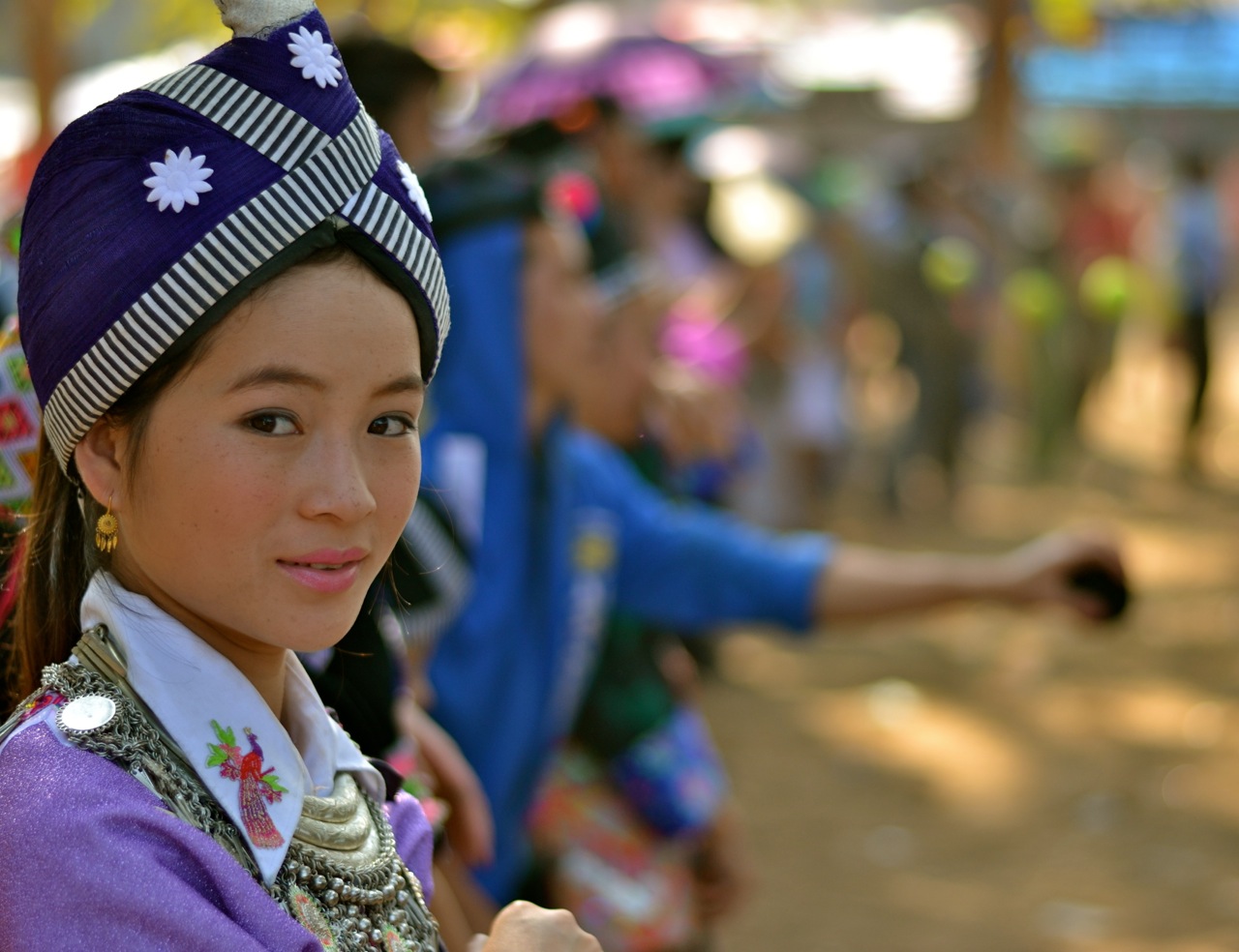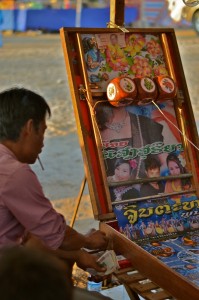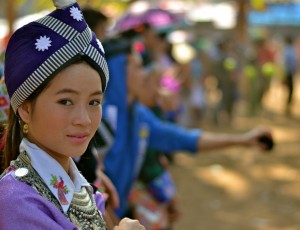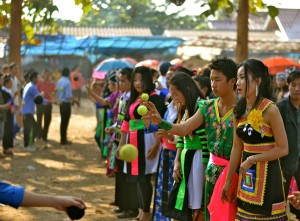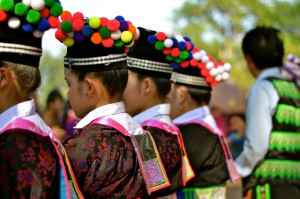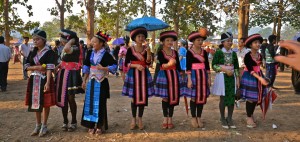The Lao Hmong New Year in Luang Prabang
“Easy. Just fo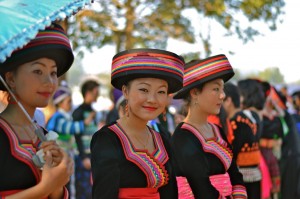 llow the crowds in traditional dress,” instructs Jua, one of my Hmong friends, when I ask how to find the Hmong New Year celebrations in Luang Prabang, Laos. Turns out it really is that simple. One crisp Saturday morning in early December I crest the hill next to Nam Vieng Kham Market and there sits a truck full of young Hmong men and women in traditional dress. I follow them across the new bridge and towards the airport, where they descend amongst a flurry of other festive Hmong people of all ages.
llow the crowds in traditional dress,” instructs Jua, one of my Hmong friends, when I ask how to find the Hmong New Year celebrations in Luang Prabang, Laos. Turns out it really is that simple. One crisp Saturday morning in early December I crest the hill next to Nam Vieng Kham Market and there sits a truck full of young Hmong men and women in traditional dress. I follow them across the new bridge and towards the airport, where they descend amongst a flurry of other festive Hmong people of all ages.
A windy path snakes through neighborhoods, and a peek along each corridor reveals a young Hmong touching up makeup and straightening ornate silver necklaces on outfits that have been meticulously crafted throughout the year. 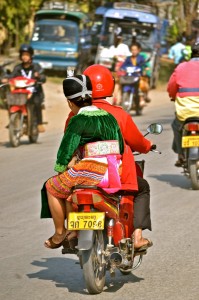
It seems like a backstage of sorts, a final prep before the big show. This labyrinth suddenly awakens to an expansive carnival style atmosphere. The first area is lined with games: darts, slingshots, gambling with oversized dice, and an inflatable ‘palace.’ A few more steps find a stage where middle-aged men give speeches, interspersed with traditional instruments, song, and dance.
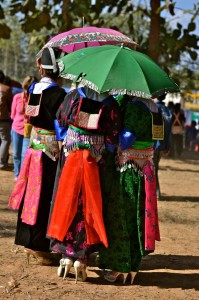 Suddenly I’m enveloped in the swirling smoke of dozens of food vendors. Fish, sausage, fried chicken feet, sticky rice, garlic, onion, and the ubiquitous lemongrass permeate my senses just as a shot of hot pepper smacks the searing skillet next to me and, akin to a carnival dart, drills the back of my throat to send me scurrying along.
Suddenly I’m enveloped in the swirling smoke of dozens of food vendors. Fish, sausage, fried chicken feet, sticky rice, garlic, onion, and the ubiquitous lemongrass permeate my senses just as a shot of hot pepper smacks the searing skillet next to me and, akin to a carnival dart, drills the back of my throat to send me scurrying along.
I abruptly find myself among hundreds of young Hmong men and women standing facing one another, tossing a cloth ball back and forth. Here I have stumbled into one of the most important rituals of this Hmong New Year, courtship.
Hmong society is divided into clans and these clan groups are exogamous, meaning Hmong may not marry within their own clan group. As traditional Hmong villages are small, and the majority of the year is dedicated to the planting, care, and harvest of rice, this significantly slims ones chances of finding a partner. Hence the importance of the Hmong New Year, a celebration of the end of harvest-thus, the beginning of a new year-a giving of thanks so that a new life may begin. Also, a gathering of smaller communities, and the ideal time to find a future husband or wife.
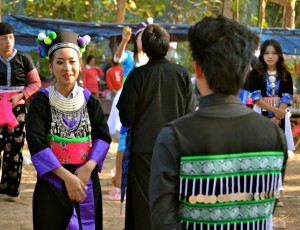 This is where the Hmong ball tossing game, or pov pob, takes shape. Boys and girls form two separate lines facing one another. Girls can toss the ball to other girls, but boys cannot toss to boys. It is also taboo to throw to members of the same clan. Traditionally, if someone drops the ball, an ornament or piece of their outfit must be given to the opposite pair. These items are recovered by singing traditional courting songs to the opposite player. There you have it, an icebreaker of sorts, the prelude to speed dating, and a splendid cultural sight to behold. Hmong people usually get married after the New Year in accordance with the new moon, something Hmong live by, and the beginning of the new season.
This is where the Hmong ball tossing game, or pov pob, takes shape. Boys and girls form two separate lines facing one another. Girls can toss the ball to other girls, but boys cannot toss to boys. It is also taboo to throw to members of the same clan. Traditionally, if someone drops the ball, an ornament or piece of their outfit must be given to the opposite pair. These items are recovered by singing traditional courting songs to the opposite player. There you have it, an icebreaker of sorts, the prelude to speed dating, and a splendid cultural sight to behold. Hmong people usually get married after the New Year in accordance with the new moon, something Hmong live by, and the beginning of the new season.
The Hmong New Year is specifically a handful of in house rituals, and the festivities such as pov pob that garner all of the attention are icing on the cake. Some of these in house rituals are; “Hu Plig” (Calling Spirit) the Hmong traditional ritual of calling home all of the wandering spirits of the household; “Txi Xwm Kab” is the ritual of honoring the God of Wealth and Riches, where a shrine is made and goods are offering so that the new year may bring wealth; “Noj Peb Caug” literally translated “Eat Thirty” is the in home celebration forthree days, wherein family members and community members are invited to dine on ten dishes served each day, hence the “Eat Thirty.”
